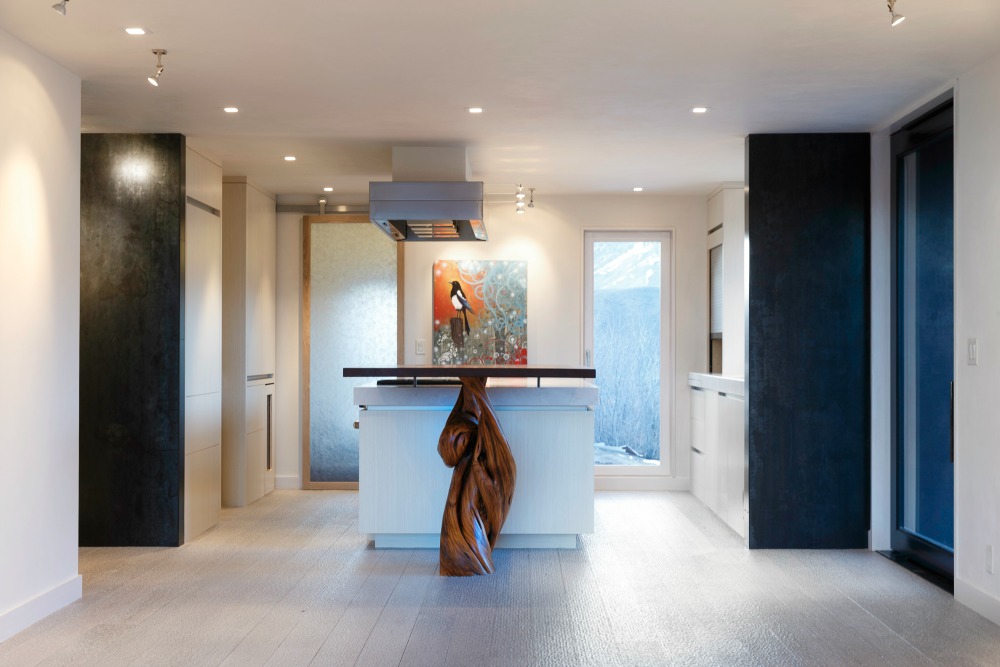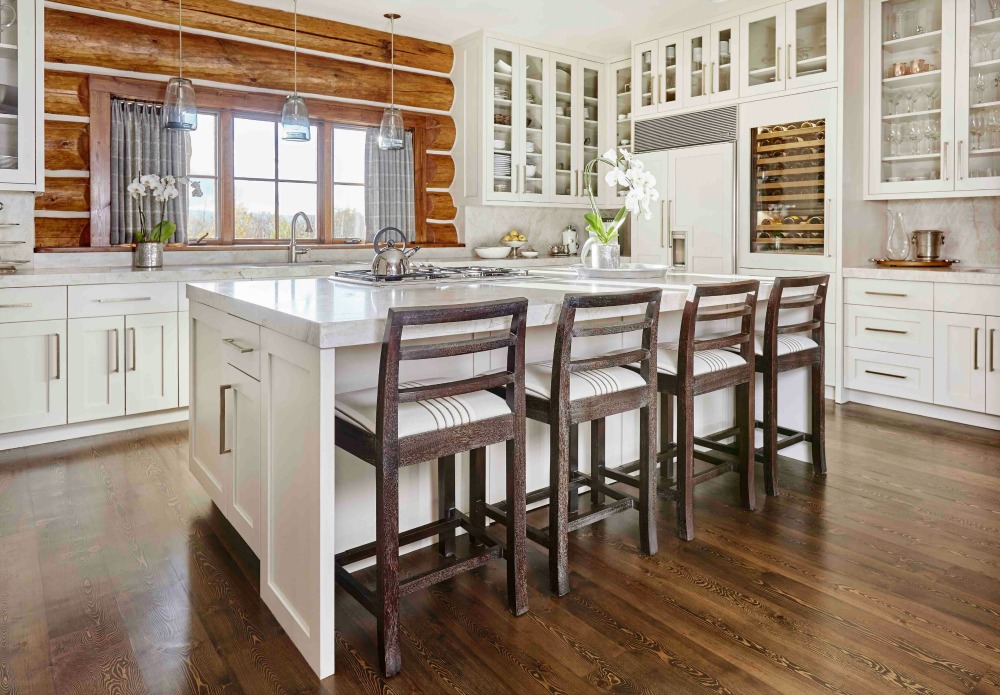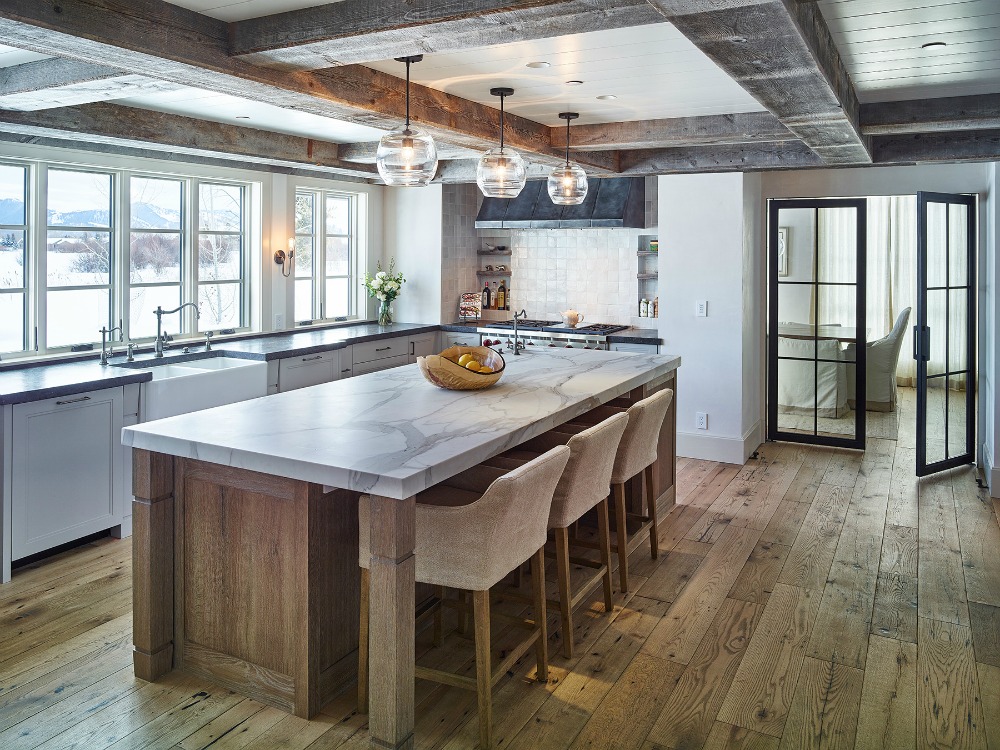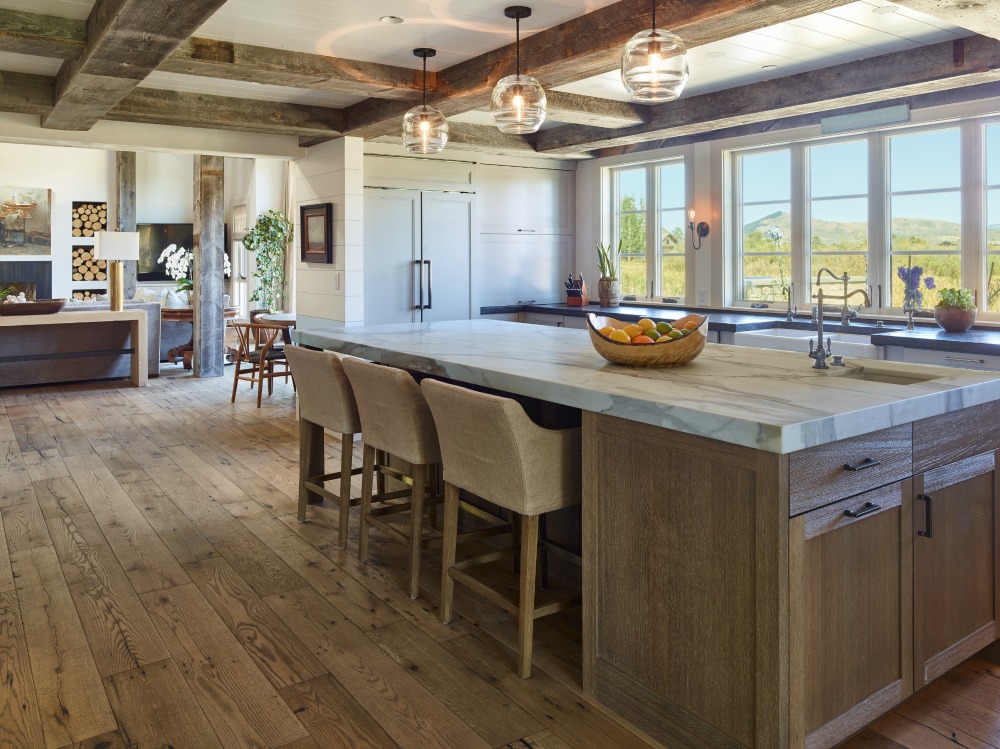As a young girl, Veronica Schreibeis-Smith was raised to cook with Crisco. She learned to cook in what she describes as a conventional kitchen with her parents or grandmother by her side at a countertop of heavy appliances where a nearby pantry stacked with canned and packaged foods stored at room temperature waited for recipes fundamental to a traditional American diet. The kitchen’s upper cabinets were typically filled with dishes, glasses and other food items that were often hidden, and although her biscuits were fluffy, years later her intuition told her there was a better, healthier way to transform a room so central to our lives that she set about changing it. By fusing her vocation of architecture and her passion for environmental psychology, she is now practicing ‘wellness architecture.’
“Why do we still embrace kitchens designed to store dead-food and non-food in dark cupboards to be consumed months or even years later? We don’t want to eat like that anymore. We want living, healthy, organic local food.” Agreed. So how do we alter what is conceivably the most vital room in our home, a conventional kitchen into a wellness kitchen? As CEO and founder of Vera Iconica Kitchen and chair of the Global Wellness Institute’s Wellness Architecture Initiative, her namesake Jackson, WY-based firm, Vera Iconica Architecture is quite literally on its way to impacting the lives of those who care about not only about the source of their food, but also about its preparation, storage, growth, and its effect on our rituals, habits and longevity.
But before reconfiguring the kitchen, what exactly is wellness architecture? “It’s creating a place of reprieve and balance. In our society, we are moving at an unsustainable rate so we have to counterbalance that by making sure our environments are healthy,” says Schreibeis-Smith. From building practices that include carbon management, water quality, and lighting, to designing green spaces that connect with nature to support healthy communities, wellness architecture is active, intuitive design that accounts for the physical, psychological, emotional and spiritual aspects of our daily lives. Its aim is to optimize our indoor and outdoor environments with design elements that holistically enhance our wellbeing. Science has proven that our surroundings directly impact our behavior. Where we live impacts how we live.

The Wellness Kitchen is more than a pretty space. “With design we have made kitchens attractive. This is not a new idea. You need beauty and organization and kitchen designers have been doing a great job. But how can our kitchens nourish us? What if these spaces fed our souls and supported our lifestyles?” Schreibeis-Smith asks.
Here’s an example. In a conventional kitchen, grocery items are heavily wrapped in paper, plastic and aluminum that can leech into the food itself and add to our expanding landfill. In a wellness kitchen, fresh produce is grown and harvested from in-house gardens without potential toxins from growing or packaging and there is no contribution to landfill. Another example is being able to visualize what your next meal might be. In a conventional kitchen, that huge refrigerator acts as a barrier between you and its contents. Digestion begins with the eyes and seeing ripe, preservative-free fruits and vegetables at eye-level through sliding glass doors is key to making the choice of whether to eat a handful of carrots or grab a bag of chips. Then there’s the food prep. It’s more fun to cook with others. The first place people gather in the morning, after school, or during a party is the kitchen. There’s a reason it’s dubbed the heart of the home—maybe it’s because it is actually the heartbeat of our bodies and our homes. Eating replenishes the body, yes, but it also serves to nourish the soul when it is prepared simply in a clean, minimal, and natural environment (without distraction), from living ingredients (just picked herbs and veggies), while prepared on a grill or with fire (without a microwave) and enjoyed with family and friends (because they connect us with our food source) and more often than not provide comfort and healthy nourishment (with the possible exception of a mischievous holiday).
Ponder the fact that in a conventional kitchen there is likely a trash compactor. It takes the brunt both visually and physically of compacting large amounts of waste, which is likely not recyclable. Now replace the conventional methods of prepping and cooking your food with wellness in mind (utilizing bulk ingredients, eating fresh produce) and it’s feasible that Schreibeis-Smith’s flash freeze Fro-Post™ compacting composter could easily do the job of freezing that waste. Now a frozen block of organic material could start new lives (more fruits and vegetables) in the soil of a family garden or neighborhood farm. This is a sustainable and environmentally conscious way to dispose of waste when one considers that “one third of the food produced in the world for human consumption every year, roughly 1.3 billion tons, is lost or wasted—a sobering statistic. And fruits and vegetables, plus roots and tubers, all of which can be composted, have the highest wastage rates of any food,” states the United Nations.

“It’s all about how we live in a space and you don’t always have to have a space designed perfectly before you start making healthy changes.” Let’s start with the obvious low-hanging fruit. 1) Say no to plastic. Shift your mentality away from containers and packaging. Find your cloth bags and keep them in the car. 2) Purchase in bulk and transfer grains, rice, beans, even your protein powder into glass jars. They’re easy to clean and line up nicely on counters. 3) Establish a relationship with food. Think about food from a nutritional standpoint and how it relates to the nutrition of the planet. 4) When possible, remove the overhead cabinets and replace with open shelving. From dishware to glassware, everything is visual and readily accessible. 5) Buy plants and herbs. Basil, cilantro, mint—this is where it is far more convenient to snip a few leaves than to buy small amounts in plastic boxes, which are not recyclable. Grow a few herbs, then try lettuces and tomatoes.
Looking to change things up a bit more? Think about an appliance garage. This is where the food processor, industrial-size mixer, coffee maker, toaster oven and any other everyday appliance that requires a lot of space can be tucked away out of sight by a flip-up hatch or custom cabinet. De-cluttering is good for the soul. Remove the microwave. Food has a higher nutritional value without radiation. “We believe it’s more convenient but we’re sacrificing our health for convenience,” Schreibeis-Smith explains. And, those open shelves. If you’re renting or it’s not possible to remove the entire cabinet, just remove the doors and paint the insides white or a neutral and neatly stack and arrange contents. A sense of order is calming.
There are invaluable benefits of an island. A prep area where family and friends gather to cook and eat is especially welcome where food can be prepped directly on the surface and with features like a central drain and smart-edge gutters, it’s a smooth transition from appetizers to desserts. These uncomplicated actions form bonds and memories, which contribute to our overall health.

“How can we make eating healthy and convenient? To change our habits, it has to be right in front of us. I’m always asking myself, could I change that through design? If we understand the science behind the spaces that impact us and shift our focus from environmental health to human wellbeing we can create wellness architecture.”
To find out more watch Wellness Architecture: From Environmental Health to Human Wellbeing by Veronica Schreibeis-Smith on YouTube.
“If we choose beauty, simplicity, purity in the materials with which we build, we will thrive in our environments.”




